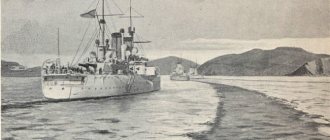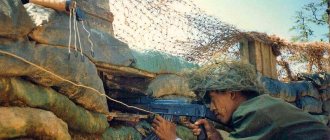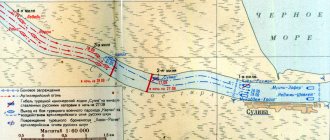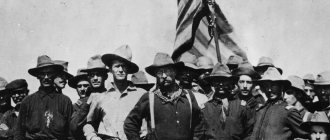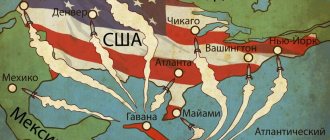Towards the end of the First World War, the phrase about the victory of the truck over the steam locomotive was born. It became obvious to everyone that oil was becoming the most important strategic factor, and major powers began to divide territories that promised hydrocarbon dividends. Throughout the next century, people will fight for the possession of oil resources. In particular, conflicts affected Latin America. Here, in 1932-1935, the Chak War took place, the bloodiest of the entire 20th century in this part of the world.
Background to the conflict
Territorial disputes between Bolivia and Paraguay over the Chaco Boreal (Northern Chaco) began shortly after both states gained independence. Paraguay gained independence in 1811, and Bolivia only in 1825, so Paraguay managed to sufficiently strengthen the border areas by placing its garrisons there.
The semi-desert, sparsely populated, resource-poor region in the interior of the continent was not particularly interested in the colonial authorities, and the Spanish administration was in no hurry to make a precise territorial delimitation of the viceroyalties of Peru (Spanish: El Virreinato del Peru) and Rio de La Plata (Spanish: Virreinato). del Rio de la Plata). Negotiations to establish an official border, which began at the end of the 19th century, led to nothing definite, and in 1905, Bolivian army units began to build forts in the disputed region.
Despite the fact that in the middle of the 19th century. Paraguay's economy developed rapidly; by 1920, the country was one of the poorest on the South American continent. The reason for this was the bloody Paraguayan War of 1864–1870, during which the Paraguayans lost about 40% of their territories.
For the most part, the territory of Paraguay is sparsely populated dry semi-desert highlands in the northwest closer to the foothills of the Andes, or mountainous jungle, swampy and impenetrable in the southeast, along the Paraguay River, so unattractive that after the end of this war no one rushed to draw new borders in remote areas. As a result, the vast region of Gran Chaco, where the borders of Bolivia, Paraguay and Brazil met, remained virtually ownerless. A huge territory with an area of about 250 thousand km² was almost undeveloped. The small indigenous population of this region, the Guarani Indians, who were engaged in cattle breeding and forestry, considered themselves Paraguayans.
Since 1920, neighboring countries, Bolivia and Paraguay, have actively begun to strengthen the border areas.
The fight for "Black Gold"
Notes
- [top.rbc.ru/economics/27/11/2012/833626.shtml Oil found in Paraguay :: Economy :: Top.rbc.ru]
- Korableva L.Yu. On the eve of the Chaka tragedy: failures of international mediation in 1931 - 1932. and the actual beginning of the Bolivian-Paraguayan war // Latin American Historical Almanac. - 2003. - No. 4. - P. 62
- Korableva L.Yu. On the eve of the Chaka tragedy: failures of international mediation in 1931 - 1932. and the actual beginning of the Bolivian-Paraguayan war // Latin American Historical Almanac. - 2003. - No. 4. - P. 62 - 63
- Korableva L.Yu. On the eve of the Chaka tragedy: failures of international mediation in 1931 - 1932. and the actual beginning of the Bolivian-Paraguayan war // Latin American Historical Almanac. - 2003. - No. 4. - P. 66
- ↑ 1 2 3 Korableva L. Yu.
Chaka Peace Conference (1935-1938): the end of the war between Bolivia and Paraguay. // Latin American Historical Almanac. - 2005. - No. 6. - P. 38. - Korableva L. Yu.
Chaka Peace Conference (1935-1938): the end of the war between Bolivia and Paraguay. // Latin American Historical Almanac. - 2005. - No. 6. - P. 39. - Korableva L. Yu.
Chaka Peace Conference (1935-1938): the end of the war between Bolivia and Paraguay. // Latin American historical almanac. - 2005. - No. 6. - P. 41-42. - Korableva L. Yu.
Chaka Peace Conference (1935-1938): the end of the war between Bolivia and Paraguay. // Latin American historical almanac. - 2005. - No. 6. - P. 42. - [masterok.livejournal.com/2808683.html How the Germans lost the war to the Russians... in South America] (Russian)
- [www.lenta.ru/articles/2009/04/29/boliv/ Bolivia and Paraguay ended a long-standing conflict]. lenta.ru. Retrieved April 29, 2009. [www.webcitation.org/65nQ2naIr Archived from the original on February 28, 2012].
Intervention by oil corporations and escalation of the conflict
When geologists suggested in 1928 that the western Chaco region in the Andean foothills might harbor rich oil deposits, interest in this desert region increased dramatically. Two “oil giants” rushed into the fight for the disputed region: the American corporation Standard Oil supported Bolivia, and the British corporation Shell Oil supported Paraguay.
The first armed clash occurred in the same 1928, when the Bolivian fort of Vanguardia was captured by the Paraguayan cavalry, and Bolivia, in response, captured the Paraguayan fortress of Boqueron. The League of Nations demanded a ceasefire, and in May 1930 negotiations began again between the two countries.
Thus, as of 1930, the population of Bolivia was 2.1 million people versus 800 thousand in Paraguay.
Since the end of 1931, Bolivia and Paraguay began intensive rearmament of their armies, and the Paraguayan government made large purchases of weapons. The Paraguayan command carried out military reform, a regular army was urgently created and 2 military academies were founded.
Bolivia had a large advantage in population and financial resources, so the country was able to purchase much more weapons.
The first handshake in history
There are no sites of pre-Columbian America in Paraguay. Majestic pyramids and temples, the heritage of the Incas, Aztecs and Mayans ended up in other countries. And in Paraguay, the Guarani Indians preserved only mythology. Paraguayans consider themselves Catholics. But Catholicism here is very unique. Catholic rituals are closely intertwined with the mythology of the Guarani Indians. They believe that you don't have to die to go to heaven.
The basis of Paraguayan society is the family. The most popular traditional activity in Paraguay is weaving, which is called nanduti - “web”. This is an exquisite handcrafted lace used in a variety of openwork designs with circular designs in linen, silk and cotton. By the way, the national flag of Paraguay has the same colors as the Russian tricolor. But not only that, in Paraguay the flag is double-sided. This is the only flag in the world, on one side of which the coat of arms of the state is depicted, and on the other - the coat of arms of the treasury of the Republic of Paraguay.
Diplomatic relations between Paraguay and Russia were established only in 1992. Therefore, Paraguay remains a terro-incognito country for Russians. But Paraguayans are very interested in Russia. They remember the Russian officers who helped them defend their sovereignty and independence. The 2022 FIFA World Cup has especially fueled interest in Russia. The President of Paraguay visited Moscow during the Championship. And even met with the Russian president. Their handshake - the first ever handshake between our heads of state - was widely discussed by the people of Paraguay and inspired great optimism and hope.
Chak War
After the Bolivians attacked the garrison of the Paraguayan town of Pitiantut on June 15, 1932, war was officially declared on May 10, 1933, which became the bloodiest war of the twentieth century. in Latin America.
In August 1932, intense fighting began in the Chaco region.
At first, the preponderance of forces was on the side of Bolivia. In addition to the fact that the country had 3.5 times the population and an incomparably more developed economy, it was actively preparing for war, having begun purchasing the latest types of military equipment from the United States and Europe. As a result, the Chak War became a kind of testing ground for testing the latest types of weapons.
The most effective type of weapon in the lifeless desert and impenetrable jungle was supposed to be aviation, so Bolivia's attention was primarily directed to it.
Poor Paraguay, which does not have its own air force, did not have access to such luxury. Paraguay did not even have a permanent army; with the outbreak of war, the government had to urgently call up untrained reservists. The Paraguayan army was led by Colonel Jose Felix Estigarribia (Spanish Jose Felix Estigarribia; 1888-1940) - a talented military leader who came from the Guarani Indians, who later became the 38th president of the country.
The Bolivians quickly moved deeper into Paraguayan territory. However, the Bolivian authorities apparently did not imagine all the problems that awaited the troops on deserted and roadless enemy soil.
Supplying and replenishing the army was complicated by the fact that the nearest railway station, Villa Montes (Spanish: Villamontes), was located almost 325 km from the Paraguayan border. Consequently, the advantages of the Bolivian army in numbers and equipment were reduced to almost zero. In addition to the lack of roads, the unbearable heat and lack of fodder did not allow the use of horse-drawn transport, so cavalry almost did not participate in this war. Plus, the local Guarani Indians clearly sympathized with the Paraguayans.
The Paraguayan troops, on the contrary, had well-established communications. Reinforcements and provisions were delivered along the Paraguay River (Spanish: Río Paraguay) to the port of Puerto Casado, then along a narrow-gauge railway to the town of Isla Poi.
By the fall of 1932, both sides realized that the Chak War would not be fleeting and easy, so new batches of weapons would be required. Bolivia spared no expense, and the Paraguayans simply captured most of the equipment as trophies.
From the beginning of 1934, there was clearly a turning point in the war - the Paraguayans began to advance to the northwest along the Pilcomayo (Spanish: Río Pilcomayo) and Monte Lindo (Spanish: Río Monte Lindo) rivers. With the onset of the rainy season, the Bolivian equipment broke down, and the Paraguayan troops stubbornly moved forward.
In 1935, Paraguayan units entered Bolivian territory; active hostilities ceased in March 1935, when the armies of both countries were extremely exhausted. In June 1935, the last battle took place near Ingavi (Spanish: Ingavi; Bolivia), ending in victory for Paraguay.
For almost 7 long years, while this senseless, cruel war lasted, both countries were exhausted. On June 12, 1935, with the mediation of Argentina, a truce was finally concluded, the war actually ended, although peace was officially consolidated only 3 years later.
On July 21, 1938, Paraguay and Bolivia signed a peace treaty in Buenos Aires, as a result of which ¾ of the disputed territory of the Gran Chaco was given to Paraguay; the border between the two countries today runs along this line. Bolivia received a narrow, 20-km corridor to the Paraguay River with the possibility of building a port there, as well as the right to navigate through Paraguayan territory.
In the Chak War, both countries suffered huge human losses (more than 250 thousand killed and wounded) and were economically devastated.
In this absurd, extremely bloody war, people died not only on the battlefield, both sides suffered huge losses from disease and appalling living conditions in their positions.
But the most ridiculous thing in this story was that oil had not been found in the conflict territory at that time, and the port on the Paraguay River, conceived for the transportation of valuable raw materials, practically turned out to be unnecessary.
Battle of Boqueron
Bolivians did not have such luxury and often learned from their own mistakes. At first they quickly moved forward, crushing small Paraguayan forces along the way. Most of the Grand Chaco was left behind. The Bolivians took Fort Boqueron near the Rio Verde River. Very quickly, significant Paraguayan forces arrived there.
Battle of Boqueron / Photo i.pinimg.com
Help. The Battle of Boqueron lasted 3 weeks - from September 7 to September 29, 1932.
This assault was the first step of the Paraguayan offensive. Then they planned to defeat the Bolivian forces with one blow even before Bolivia had fully mobilized its army. Fort Boqueron fell into the ring. Attempts to deliver food and ammunition here by air were met with bursts of Paraguayan machine guns.
For the Bolivians, Boqueron became a kind of Thermopylae, because up to 18 thousand Paraguayans fought against the 500 defenders of the fort . Over time, the defenders of the fort ran out of not only ammunition, but also water. The final assault was carried out with bayonets.
On the topic “Wolves of the Kriegsmarine”: the most successful period of German underwater hunting during the Battle of the Atlantic
The Bolivians were not very successful in using their advantage in weapons. Heavy artillery turned out to be unnecessary, since there were no large targets. Aerial reconnaissance worked hard, because the terrain covered with thickets made it difficult to make out anything.
The Paraguayans acted more effectively by attacking in small groups. According to historian Evgeniy Ivanov, their favorite tactic was to approach positions unnoticed, open fire, and leave under cover.
First aid post on the front line in Paraguay / Photo ICRC
The role of foreign military specialists
Both conflicting sides in that war took advantage of the help of foreign military specialists from Russia and Germany. German General Hans Kundt (German: Hans Kundt; 1869-1939) became the Chief of the General Staff of the Bolivian Army.
Bolivia also brought in Czech military advisers and Chilean mercenaries. Interestingly, 120 German emigrant officers served in the Bolivian army, among whom was Hans Kundt, a German military leader who commanded the Bolivian army at the beginning of the Chaca War.
At the same time, more than 80 former White Guard officers - immigrants from Russia - served in the Paraguayan army. Both of them had previously participated in World War I, the experience of which was actively used during the “Chak battles”.
Advantages of the Paraguayan army
Paraguay also had many problems that made it difficult to wage a full-fledged war. However, unlike Bolivia, where political rivals immediately began to take advantage of the conflict, Paraguay was not distracted by internal protests . The government, led by President Eusebio Ayala and Paraguayan army commander José Felix Estigarribia, side by side sought ways to fend off aggression from a much larger neighbor.
From 80 to 100 Russian officers led the Paraguayan army - 3 generals, about 10 lieutenant colonels, 50 majors and captains, said historian Yevgeny Ivanov.
Many Guarani Indians fought in the Paraguayan army. In addition to their service weapons, they had a machete, with which it was easier to pave the way through the thickets.
Final resolution of the conflict
70 years after the end of the war, on April 27, 2009, the presidents of Bolivia (Evo Morales) and Paraguay (Fernando Lugo) in the Argentine capital, Buenos Aires, signed the “Treaty on the final approval of the state border in the Gran Chaco region.”
It is clear that the Chaco War was provoked by the rivalry between two giant oil and gas corporations - the American Standard Oil and the British-Dutch Royal Dutch Shell, each of which sought monopoly control over the subsoil of the Chaco. Standard Oil provided military aid to the Bolivian regime, transporting supplies and weapons through Peru and Chile, and Shell, using Argentina, supplied Paraguay.
In the event of Bolivia's victory, the United States hoped to expand its sphere of influence on the South American continent.
The positions of neighboring countries on the current events were different. Chile, for example, supported Bolivia out of fear that if a breakthrough to the Atlantic Ocean failed, it would try to forcefully secure access to the Pacific Ocean by seizing part of Chilean territory. Brazil remained neutral, offering only mediation services to the parties.
National drink of Terere
Paraguay is a country with very friendly people. Wherever you go, the first thing you will be offered is a drink of terere. This is a local version of mate. Everyone knows that the drink mate is very popular in Latin America. In most countries, it is drunk hot from vessels made from pumpkins - calebes. But Paraguayans believe that this is the wrong mate, and only in Paraguay do they drink real, correct yerbe mate.
“The Argentine version of mate is known all over the world. Mate grass is placed in a vessel called a calabash and filled with hot water. We don't do that in Paraguay. Firstly, because we distance ourselves very much from Argentina. And, secondly, it’s much hotter here. Therefore, instead of calabashes, we use a wooden glass, which may have a layer of metal inside. We put mate grass there and fill it with ice water. Then we take a bombilla tube and drink cold mate through it, which we call terere. All our students bring these cups of terere to class and add ice water from thermoses to the drink,” says Igor Protsenko.
This drink has an interesting history, and it is again connected with the Russians. According to some sources, terere spread widely throughout the country during the Chak War. In order not to give away the location of the troops, Commander Belyaev forbade lighting fires. Therefore, they began to pour cold water into the mate. Now terere has been declared a national treasure of Paraguay - on every last Saturday of February there are even
Curious facts
- After the announcement of general mobilization in Paraguay, the size of the army increased 20 times in just a few weeks - from 3 to 60 thousand people. True, initially most of the soldiers were armed only with machete blades, and there was one Mauser rifle for 6-7 people.
- The first battles were chaotic skirmishes in the jungle and sluggish battles for individual strategic points. Both warring sides erected earthen fortifications in the areas they controlled, proudly called forts. The Paraguayans actively used the creation of a network of minefields. The units surrounded their positions with barbed wire and built dugouts with machine gun nests.
- The Chaco War was fought in the conditions of a “tropical hell”, since the climate in the Gran Chaco is so unbearable that sometimes even the Paraguayans who grew up in these conditions could not stand it.
- In order to achieve priority in armed clashes, the commander of the Paraguayan army, Colonel Estigarribia, had to appoint I.T. as chief of the General Staff. Belyaeva. All command positions (regimental commanders, battalion commanders, chiefs of staff of military formations) were also entrusted to Russian officers, one of whom commanded an entire division.
- In order to thoroughly explore the little-studied Chaco-Boreal region, draw up a detailed map of the area and clarify the border with Bolivia, in October 1924, the Paraguayan Ministry of Defense sent an expedition to the area located between the Paraguay and Pilecanoyo rivers, led by Russian officer Ivan Timofeevich Belyaev, who were on
Paraguayan service. These trips to Chaco (1924-1932) were an important contribution of Belyaev and his Russian associates to world science: during the expeditions, rich materials were collected on the geography, climatology, biology and ethnography of this region. Belyaev’s team studied the culture, life, languages and religions of the indigenous Indians, and they compiled the first dictionaries: Spanish-Chamacoco and Spanish-Mocha. - About 80 Russian officers selflessly fought in the ranks of the Paraguayan army, including 2 generals, 8 colonels and 4 lieutenant colonels and many other Russian volunteers who helped defend the independence of Paraguay in the Chac War, which thwarted the plans of Nazi Germany to establish its influence in the very center of South America.
- The future president of Paraguay, Alfredo Stroessner (Spanish: Alfredo Stroessner Matiauda; 1912 - 2006), fought in that war as a lieutenant under the command of the Russians, who, according to the dictator, made him “a real military man.”
- I. T. Belyaev is considered a national hero of Paraguay. The Russian general was buried in 1957 in Asuncion, the capital of Paraguay, with the highest military honors.
- In Asunción alone, 10 streets were named after Russian officers, such as “Basilio Serebriakoff”, “Teniente Kanonnikoff”, “Mayor Kasianoff”, “Captain Nicolas Blinoff”, “Captain Malutin”, etc.
- The Chuck War, the bloodiest in South America, which claimed a huge number of lives, became a rehearsal for World War II.
- In the very center of the Paraguayan capital, the “Pantheon of Heroes” was erected, where an eternal flame burns in memory of those who died heroically in the Paraguayan-Bolivian war.
- Large oil fields in the Chak region, because of which the monstrous war began, were never discovered in those days. Thus, the erroneous (and untimely) forecast of geological prospectors became the cause of an absurd war that led to the death of hundreds of thousands of people. Así es la vida! (from Spanish “Such is life!”)
- Under the terms of the Peace Treaty of 1938, most of the disputed territory (¾ of the Gran Chaco) was ceded to Paraguay. But at the same time, it was on ¹⁄3 of the territory that went to the defeated side that rich deposits were soon discovered, making Bolivia the owner of the largest reserves of black gold and natural gas on the continent! But the Paraguayans never found oil on the lands that were abundantly watered with the blood of their compatriots. Such is the evil smile of fate.
- However, the story may have a happy continuation, because at the end of 2012, large oil reserves were discovered on the Paraguayan part of the Chuck Pie! It seems that very soon grateful Paraguayans will name not only streets, but entire cities after Russian heroes.
[1]
Content
- 1 Background to the conflict
- 2 The arrival of oil corporations and the escalation of the conflict
- 3 Beginning of the war
- 4 Main battles 4.1 Battle of Boqueron
- 4.2 Rearmament and Nanav Campaign
- 4.3 Nanawa-2
- 4.4 Campo Via
- 4.5 Battles of Piquiba and El Carmen
- 4.6 Last battles
Links
- Chak War 1932-35
- article from the Great Soviet Encyclopedia. - [interpretive.ru/dictionary/960/word/%D7%E0%EA%F1%EA%E0%FF+%E2%EE%E9%ED%E0 Chak War 1932-35] Oxford Illustrated Encyclopedia: World History (since 1800 to this day)
- [commi.narod.ru/txt/ek/107.htm Evgeny Kiselev: Chak War.] An article about the role that Russian and German officers played in it.
- [greenbag.ru/paraguay/russkie-dobrovoltsy-v-voine-za-chako Sergey Gorbatykh: Russian volunteers in the war for the Chaco.] An article about Russian volunteers who fought on the side of Paraguay in the war for the Northern Chaco.
- [topwar.ru/20276-russkie-v-boyah-za-paragvay.html Igor Khodakov: Russians in the battles for Paraguay.] An article about the role of General Belyaev in the Chaka War.
- [www.pravmir.ru/paragvajskaya-prelyudiya/ Vasily Terentyev: Paraguayan Prelude.] Essay on the technology, tactics and strategy of the Chaka War - rehearsals for the Second World War.
last years of life
During expeditions to Chaco-Boreal, Belyaev actually discovered the tribes of the indigenous inhabitants of the Gran Chaco to the outside world. He himself pursued one important goal - to obtain from the authorities a “humane” attitude towards the Indians.
At the same time, the Russian scientist warned against attempts to destroy the way of life of the Indians that had developed over centuries, since this would only alienate the freedom-loving Redskins from the “white man’s culture.”
Belyaev’s efforts were not in vain. In October 1943, Ivan Timofeevich finally received permission to create the first Indian colony-school, which was named after Bartolomé de Las Casas (Spanish: Bartolomé de las Casas - Spanish Dominican priest, historian of the New World, known for his struggle against the oppression of the Indians Spanish colonists). By a special decree, settled Indians with huts in Chaco were assigned land ownership. The following year, the position of a special observer for the observance of the constitutional rights of the country's Indian population was officially approved, and Belyaev was given the title of General Administrator of the Indian Colonies in Paraguay.
The first 250 Indians of the Macca tribe settled on an island near Asuncion. Everything necessary for the development of the colony was purchased with money received from performances of the Indian theater, as well as donations from members of the Association and simply admirers of Belyaev. A school was built on the island - an ordinary hut with a reed roof, where Belyaev himself taught the little Indians to read and write.
The last years of the White Father's life were entirely devoted to the Indian colony. In the settlement, Belyaev lived in a simple hut, which was constantly filled with Indians. The “White Teacher” taught his students the basics of history, geography, social life and personal hygiene. Belyaev taught classes in various local languages and dialects, which he himself knew more than ten. He translated the Holy Scriptures into the Indian language.
Elderly Indian colonists were engaged in gardening. The men mostly hunted. And women were engaged in traditional crafts - soon many Asunción fashionistas began to flaunt jewelry made from ostrich feathers made by Indian women. Leather goods, woolen carpets and ponchos decorated with ancient Chak ornaments were very popular. The sanitary condition of the colony and the health of its inhabitants were regularly monitored by medical workers - members of the Association.
Over time, the White General became a landmark of the Paraguayan capital. Foreigners visiting Asuncion first wanted to meet “Juan Belyaeff.” He was a handsome old man of short stature, with the classic beard of a Russian officer and eyes that radiated wisdom and kindness. Some immigrants treated Ivan Timofeevich as an old man who had lost his mind and was a disgrace to the Russian nation.
But, most importantly, the former tsarist general managed to win great respect and love from the Chaco Indians. Belyaev received the proud Indian name “Elebuk” (“Strong Hand”), and the Tiger clan of the Chamacoco tribe proclaimed him their White Leader. Having learned about this, Belyaev’s acquaintance, historian and writer Mikhail Karateev, wrote that he could not contain his smile: “Small, short-sighted, puny and good-natured Belyaev resembled a tiger, like a nail at a funeral service. At home, his wife affectionately called him Zainka, the same nickname was adopted by close friends, and this suited him much more.”
Apparently, the Indians saw something special in him, which was the reason for assigning Belyaev to the Tiger clan.
Love
Ivan Belyaev did everything to the maximum - he lived through a ruptured aorta, studied well, and served bravely. And he loved – selflessly, to the very bottom of his soul.
On the eve of the harsh year 1905, he met a girl who charmed him. Love broke out. Maria was not from the noble class, and, according to the guards regulations, the officer could not marry her. But for the sake of his beloved, Belyaev was ready to do anything; he decided to have a secret wedding. True, the wedding had to be temporarily postponed: 1905 was blazing outside. And Belyaev’s battery is urgently aimed at suppressing the sailor mutiny in Kronstadt.
Returning to St. Petersburg, Ivan secretly married Maria. The brigade command, taking into account the exemplary service and personal courage shown by Belyaev during the suppression of the Kronstadt rebellion, decided to turn a blind eye to the officer’s hazing act. Two years later, in the fall of 1907, Maria died in childbirth. After the funeral of his beloved wife, Ivan swore to himself that he would never have children...
A year later, the officer met Alexandra Zakharova, a young employee of the St. Petersburg post office. The girl captivated Belyaev with her modesty and quiet beauty, but most importantly, with her amazing resemblance to Maria. For the sake of his Alechka, a girl of merchant origin, Ivan Timofeevich submitted a report on leaving the guard. The young people got married, this time openly. Soon Belyaev received an appointment to the First Caucasian Rifle and Artillery Division, and the young couple left their native Petersburg.
early years
Ivan Timofeevich Belyaev was born on April 19, 1875 in St. Petersburg. He became the 5th child in a family of a hereditary military man. The parents, captain of the Izmailovsky Guards Regiment Timofey Mikhailovich Belyaev and his wife Maria Ivanovna, already had three sons and a daughter growing up. Unfortunately, Vanya's mother died 5 days after his birth.
A year later, the father married again. The children's relationship with their stepmother did not work out. Having received a service appointment in Warsaw, the father sent his children to their maternal grandmother and grandfather. So, by the will of fate, Ivan’s childhood years were spent on Vasilyevsky Island, in a small family estate in the village of Leontyevskoye, Gdovsky district.
It must be said that Ivan Timofeevich’s great-grandfather on his mother’s side, Leonty Fedorovich Trefurt, a diplomat of Catherine’s school, was Suvorov’s adjutant and accompanied the legendary commander on campaigns. Another maternal great-grandfather, Rear Admiral Andrei Ivanovich Elliot, a descendant of an old Scottish family, came to Russia at the invitation of Catherine II to revive the Baltic Fleet.
The mansion had a good library. Little Ivan spent long hours among books, reading stories about travel; he especially loved the adventure novels of Fenimore Cooper and Mine Reid.
It was in childhood that young Belyaev first met distant Paraguay. This happened in the attic of the estate, where in the archives of his great-grandfather he dug up an old book with a map of Paraguay from the 17th century. Later, in his grandfather’s library, in a file of old magazines, Ivan read about the terrible war in the New World, which lasted 6 years (1864-1870). The boy was delighted by the courage of the Paraguayan people, who fought the invaders to the last drop of blood.
7-year-old Vanya fell in love with an overseas country and the proud Indian people in absentia. He read all the available literature on this topic. “Every night I prayed fervently for my beloved Indians,” Ivan Timofeevich later recalled.
Education, service
At the age of 11, Ivan Belyaev entered the 2nd St. Petersburg Cadet Corps, where his older brothers studied. After graduating from the Cadet Corps in 1886, the young man entered the Mikhailovsky Artillery School. Ivan studied easily. Based on the results of the final exams, cadet Belyaev was among the 17 graduates who received the highest “Guards score” and was assigned to the rank of second lieutenant in the 2nd Artillery Brigade of the Life Guards. At the highest review in the summer of 1895, the emperor personally presented Ivan Belyaev with officer's shoulder straps and the prestigious guards service began.
Soon the overexertion during the years of study took its toll - pain in the heart began to bother him, and Belyaev received leave to the Caucasus to improve his health. Ivan traveled for more than 2 months along the Mineralnye Vody-Grozny-Vladikavkaz route. It was in the Caucasus that he wrote his first scientific work - the article “On the Land of the Khevsurs.”
Returning from vacation, Belyaev published a brochure at his own expense. Unexpectedly, this small work received a powerful resonance in scientific circles, and Lieutenant Belyaev became the youngest member of the Imperial Geographical Society in history. Continuing his service in the regiment, in the evenings Belyaev disappeared into the library of the Geographical Society, where he immersed himself in the history of Paraguay and the study of the life of the Indians.
All his days were occupied with military disciplines, and his nights were completely devoted to the passion that had captured Ivan since childhood. He also diligently studied Spanish.
Ivan Belyaev and the Indians – face to face meeting
Finding himself in the region inhabited by Indians, Belyaev took it as a gift of fate. He wanted to find an optimal solution to the problem without harming the tribes living in Chaco. The general sought to combine the military goals of the expedition with scientific and humanitarian ones. Belyaev understood that this could only be accomplished by establishing relationships with the Indians, cut off from civilization.
Finally, Belyaev came face to face with the subject of his childhood dreams - real South American Indians. With a respectful attitude and sincere interest in their history, the “white general” gained great authority among the “bronze-skinned children of the jungle.” And if in the first expeditions the aborigines assisted the “Belyaevites” only as guides, then later entire tribes helped a detachment of white explorers in search of reservoirs and optimal routes to remote points of the Chaco-Boreal.
“I was happy to communicate with these courageous, silent, unpretentious people, tempered by Mother Nature.”
(from the notes of Ivan Belyaev)
He studied the life, culture, languages and religions of the local Indians. As a linguist, Belyaev compiled the first dictionaries: Spanish-Mocha and Spanish-Chamacoco. The research of the Russian scientist helped to understand the complex tribal and ethnolinguistic structure of the Indian population of Chaco. Notes about the natives of Chaco are of particular value because the author comprehended the life of the Indians from the inside.
During long expeditions, Belyaev translated the Indian poem “Amormelata” (“The Great Flood”) into Russian, collected and recorded oral folk tales, legends and songs. Ivan Timofeevich not only studied the life of the Indians - he fell in love with this culture with all his heart. The proud Redskins also considered him their friend.
It was thanks to the friendship of Ivan Belyaev with the Indians that the Armed Forces of Paraguay managed to stop the penetration of the Bolivians into the Chaco region in time.
Protector of the Paraguayan Indians
The failed founder of Russian Hearth did not fall into despair. Belyaev still had a passion that called to action from his youth - to study and protect the “bronze-skinned children of the jungle.”
In 1936, Ivan Timofeevich again plunged into studying the life of the Indians. He did what he loved until his last breath.
In 1937, the general, who had already left military service, became the head of the fight for the rights of Paraguayan Indians. In May 1937, on the initiative of Belyaev, the National Patronage for Indian Affairs was created under the government of Paraguay. The candidacy of the Director of the Patronage, of course, was not even discussed.
The creation of Indian schools, the attraction of Russian teachers to these schools, the creation of a medical care system for tribes, the recognition of the Guarani language as the second state language of Paraguay along with Spanish, the adoption by the government of the “Declaration of the Rights of the Indians” - these are just the main stages of the Patronage’s activities. Belyaev developed an innovative approach to the issue of introducing the Indians to modern civilization. He created many published works on ethnography, history and culture of the Indians and opposed any imposition of European culture on the indigenous peoples.
In addition, a practical application was found for Belyaev’s poetic and dramatic gift. In April 1938, the premiere of the play “Indian Fantasy” was sold out at the National Theater of Asuncion, in which only Macca Indians performed. The storyline of the production was based on one of the heroic episodes of the Chak War. The author of the libretto and the director of the troupe was Belyaev. The orchestra was conducted by the famous Paraguayan composer Jose Asunción Flores (Spanish: Jose Asunción Flores; 1904-1972), who widely used Indian folklore in his work.
After some time, the first Indian troupe in American history of 40 people, led by Belyaev, went on tour to Buenos Aires, where the artists were met with resounding success. These unprecedented tours, which lasted 3 months, brought good results: the Paraguayans returned to their homeland with a substantial sum and the desire to buy a plot of land to organize an Indian school.
The Argentines, greatly impressed by what they saw, raised the issue of equal rights for Indians in their country.
